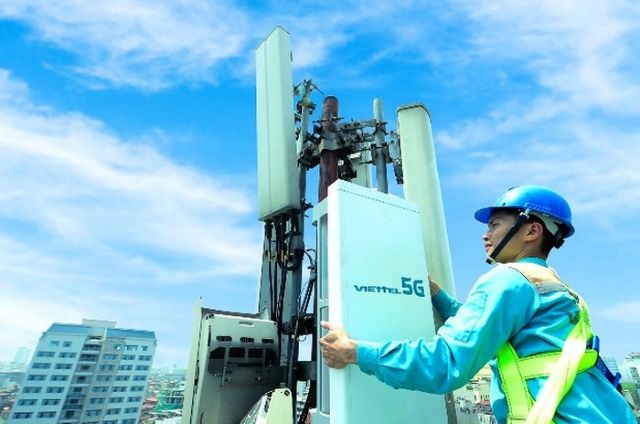 Economy
Economy


|
| A 5G signal booster installed by military telecommunication group Viettel in Hà Nội. — Photo vnreview.vn |
HÀ NỘI — Vietnam Post and Telecommunications Group (VNPT) on Saturday announced it will officially deploy VinaPhone 5G network in Hà Nội and HCM City.
This is a milestone in Việt Nam's technology development as 5G technology is bringing about important changes in all aspects of social life while at the same time laying a solid foundation for building a digital government in the country.
Upon the successful launch of the Vinaphone 5G network, Deputy Minister of Information and Communications Phan Tâm said to date, three big telecommunications and information technology enterprises have helped Việt Nam advance into the one of the leading countries in 5G deployment worldwide.
Experts have agreed the ownership of 5G equipment has a national strategic meaning.
All three major carriers in Việt Nam, including Viettel, VinaPhone, and MobiFone, have deployed 5G networks in Hà Nội and HCM City. With speeds 10 times higher than the current 4G, 5G is expected to solve data network problems while providing smoother speed experiences.
At a seminar on opportunities of 5G to Việt Nam last week, Nguyễn Phong Nhã, deputy director of Việt Nam Telecommunications Authority (VNTA) under the Ministry of Information and Communications, said after enterprises completed commercial trials, carriers would submit evaluation reports on technical features, commercial capacity, and market demand in the future for state management agencies, particularly, the Ministry of Information and Communications, to complete legal bases.
Nhã said that the deployment of 5G in Việt Nam would depend entirely on market demand.
The reason for choosing big cities such as Hà Nội, Đà Nẵng, and HCM City was because these were areas with a high density of mobile device users and high demand for speed, said Nhã.
In addition, 5G could also be deployed in industrial zones where there was a need to design, operate and install smart factories, the Ministry of Information and Communications expected to soon deploy this service next year, he added.
Sharing at the seminar, a representative from VinaPhone said through the technical testing in Hà Nội and HCM City, the 5G network had given downlink download speed 10 times faster than 4G network, while latency is 10 times less.
With MobiFone, this operator has completed the installation and is testing the 5G speed. Under standard conditions, the results are relatively satisfactory when download speeds reach around 1.3 Gbps.
The operator forecast that the speed of 5G would increase even higher in the future.
The entire network of Viettel currently has about 8,000 terminals that are compatible with the 5G network. However, due to the narrow coverage area, only a few hundred devices are currently connected to the test network. The average speed is currently about 500-600 Mbps.
The appropriate timing of 5G deployment is also a matter to consider.
"If we deploy 5G late, it will turn opportunities into challenges, will go later, not catch up with countries, restrict socio-economic development. If it is deployed too soon, it will cost a lot of investment of enterprises," noted former Deputy Minister of Information and Communications Lê Nam Thắng.
At the seminar, participants agreed that the ownership of 5G equipment has a national strategic meaning and Việt Nam was one of the few countries in the world that could produce 5G equipment.
The deployment of 5G in Việt Nam was advantageous when Việt Nam's electronics and telecommunications businesses actively produced information equipment and telecommunications infrastructure, while we had to buy and depend on foreign producers in the past, said the participants.
This was an important step for socio-economic development and national security and defence, they said. — VNS




